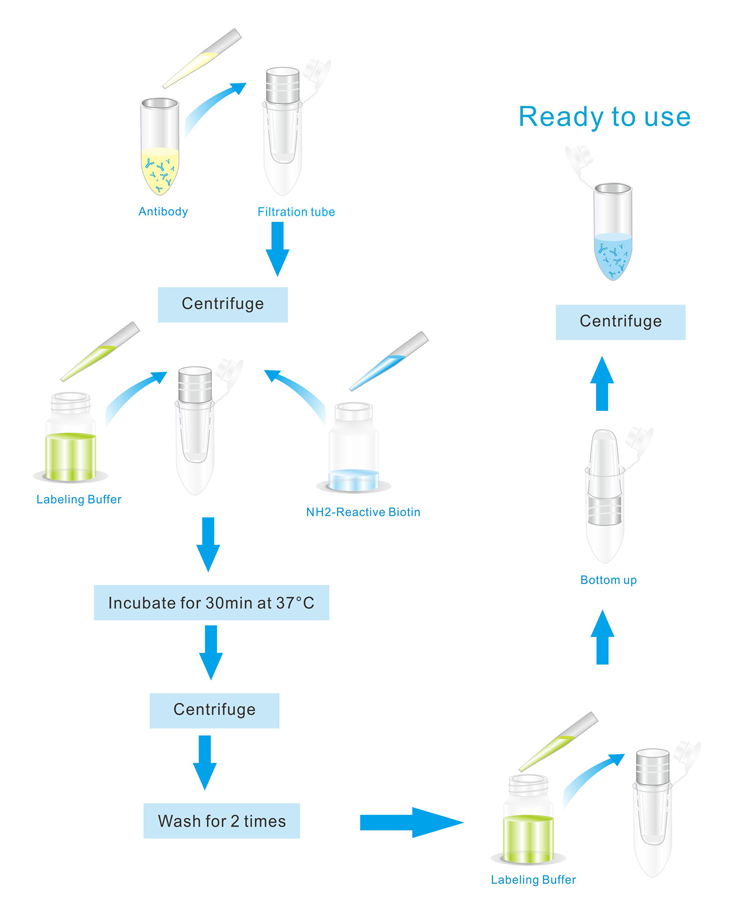Catalog Number: EBF0003
Introduction
The FITC Labeling Kit of Elabscience offering a collection of reagents required for FITC labeling is designed to label antibody with amidogen (NH2-). The specially treated FITC in this kit can be used directly. The reagents are enough for approximately 3 labeling reactions each containing 0.1-2 mg of antibody or other protein. Each kit includes 3 Filtration tubes for desaltination of antibody labeling without the need for dialysis. The whole procedure is simple and can be completed in 100 min with proficient operation.
Features
- All-inclusive:This kit provides all the reagents required for FITC labeling.
- Quick: The whole procedure only takes 100 min.
- Convenient:Desaltination can be achieved with Filtration tube, dialysis or gel filtration is not necessary.
- Flexible:The procedure can be easily adapted to both smaller and larger scales, with 0.1-2 mg of protein labeled each time.
- Perfect results:This kit has been optimized to determine the optimum labeling ratio of FITC to antibody, lowering the possibility of protein inactivation resulted from insufficient labeling or excess FITC labeling.
Components
| Component | Amount |
| FITC | 0.3 mg/vial×3 |
| Labeling Buffer | 10 mL×1 |
| DMF | 500 uL×1 |
| Filtration tube | 0.5 mL/tube×6 |
Materials required but not included in this kit
- 10μL,50μL,200μL,1000μL adjustable pipettes
- Incubator (37°C)
- Centrifuge (the centrifugal force can be up to 12,000×g)
Storage
The kit is stable for 1 year at 2-8°C before opening.
Principle of the assay
Protein bonds covalently to FITC by thiourea connection as free amino groups of lysine residues in the protein molecule can react with nucleophilic FITC.
Calculation on the amount of FITC
The volume of FITC used in each reaction depends on the amount and concentration of the protein to be labeled. When labeling 2 mg /ml of antibody (IgG, 150 KD), taking antibodies and FITC with the mass ratio of 1 mg: 150 μg can achieve better marking effect.
Assay protocol
Preparation before experiment:
- Read the manual carefully.
- Calculate the volume of FITC to be added.
- Bring the kit to room temperature 20 min before experiment (Note: put the unused FITC back to the refrigerator).
- Dissolve FITC: add 30 μL of DMF to the vial of FITC, let it stand for 10 min until it dissolved fully. The concentration of FITC is 10 mg/ml now.
Assay procedure(we label 1 mg of protein in this assay)
- Add 1mg of protein sample and corresponding volume of Labeling Buffer to a Filtration tube to make the total volume is 0.5 mL. Centrifuge at 12,000×g for 10 min. (Note:①The maximum volume of Filtration is 0.5 mL. ②The protein sample can be treated with centrifugal ultrafiltration first when at low concentration.)
- Add 15 μL of FITC and appropriate volume of Labeling Buffer to the Filtration tube, making the final concentration of the protein solution is 2 mg/mL. Mix it thoroughly with a pipette and incubate the tube for 60 min at 37°C.
- Centrifuge at 12,000 x g for 10 min
- Add appropriate Labeling Buffer to the Filtration tube to make the total volume is 0.5 mL. Mix it thoroughly with a pipette and centrifuge at 12,000×g for 10 min. Repeat this step once again.
- Add 0.2mL Labeling Buffer to the Filtration tube and mix it thoroughly with a pipette. Invert the filtration tube and put it into another centrifugal tube. Centrifuge at 6,000×g for 10 min.
- Collect the solution in the centrifugal tube, namely antibody labeled by FITC.
Precautions
- This kit can also be used to label antigen, HRP and polypeptides with amidogen (NH2-). The labeling ratio depends on the amount of amidogen.
- DMF should be preserved airtight in a dry place. Seal it with the parafilm immediately after use.
- In the step 5 above, Labeling Buffer is used to collect the labeled protein. You can also use other buffer or protective agents as you like.
- This kit can be stored for 1 year before opening. Please use it before within the expiration date.
- The Filtration tube provided in this kit has a molecular weight cutoff (MWCO) of 10 KD. So please be careful of the molecular weight of the antigen or polypeptide to be labeled.
- In the step 2 above, for other quality antibodies, we should control the final concentration of antibody is 2 mg/ml strictly, and then calculate the volume of FITC required according to the quantity of the antibodies.The Filtration tube provided in this kit has a molecular weight cutoff (MWCO) of 10 KD. So please be careful of the molecular weight of the antigen or polypeptide to be labeled.
- Ensure no free amino-group being introduced during the coupling process. (Tris, ammonia and sodium azide can react with the activated FITC, thus reducing the conjugation rate of protein-FITC).


